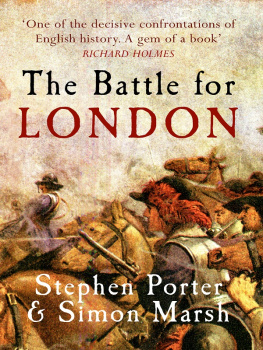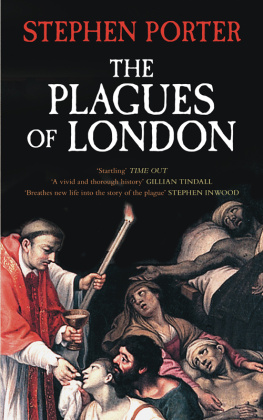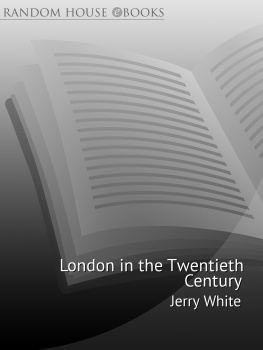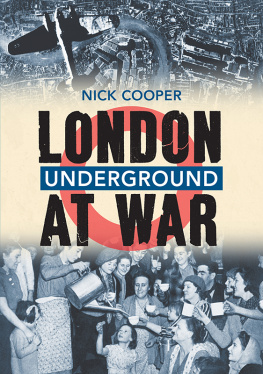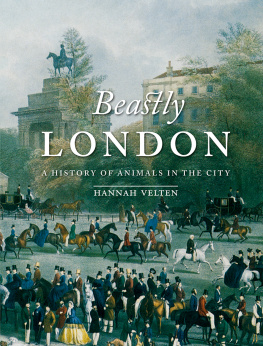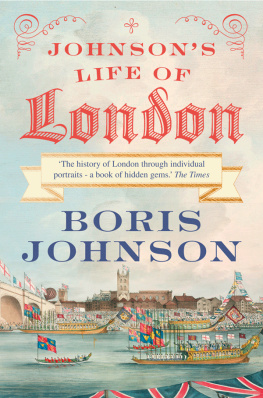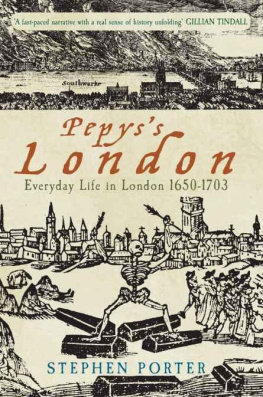Th e Battl e f o r
L O N D O N
This edition first published in Great Britain 2012
Copyright Stephen Porter and Simon Marsh 2011, 2012
This electronic edition published 2012 by Amberley Publishing
Amberley Publishing
The Hill, Stroud
Gloucestershire, GL5 4EP
www.amberleybooks.com
The right of Stephen Porter and Simon Marsh to be identified as the Authors of this work has been asserted in accordance with the Copyrights, Designs and Patents Act 1988.
All rights reserved. No part of this book may be reprinted or reproduced or utilised in any form or by any electronic, mechanical or other means, now known or hereafter invented, including photocopying and recording, or in any information storage or retrieval system, without the permission in writing from the Publishers.
eISBN 978-1-4456-0929-4
Visit www.amberleybooks.com to find out more about our books, authors and special offers.
Th e Battl e f o r
L O N D O N
S t ephe n P o rt e r &
Simo n Ma r s h
AMBERLEY
Con t ents
W e are very grateful to Malcolm W anklyn and Richard Holmes for reading the manuscript and making helpful comments, and to John T ince y , Keith Roberts and Glenn Foard for discussions about the Edgehill part of the campaign and the deployment of seventeenth-century armies. James W isdom, V al Bott, Jonathan Smith, Peter Norton, Janet McNamara, Sam Hearn and Howard Simmons of the Brentford and T urnham Green battlefield interpretation project helped to raise awareness in this important phase of the Civil W a r . W e have conducted annual walks of the two battlefields for several years on behalf of the Battlefields T rust and have received helpful information and pertinent questions from those who have attended, for which we are also grateful. Jonathan Reeve of Amberley has provided much support during the publication process. Over a far longer period, our families have given boundless help and encouragement in what has been a lengthier project than either of us anticipated.
Whe n contemporarie s cam e t o reflec t o n th e outcom e o f th e civi l war s i n th e 1640s , the y accepte d tha t London s rol e ha d bee n o f crucia l importance . A s th e nationa l capita l an d b y fa r th e larges t cit y an d seaport , i t ha d resource s o f manpowe r , mone y , arm s an d equipmen t unmatche d b y an y othe r cit y o r region . Londo n remaine d aligne d wit h parliamen t throughou t th e period , bu t it s allegianc e wa s no t predetermine d an d th e cit y ha d t o b e secured , bot h politicall y an d militaril y . Thi s wa s achieve d a t th e outset , initiall y whe n parliament s supporter s i n th e Cit y secure d contro l o f it s administratio n throug h a reversa l o f politica l fortune s a t Guildhall , an d subsequentl y b y haltin g th e king s arm y tha t wa s inten t o n militar y capture , rathe r tha n a negotiate d settlement .
By the middle of the seventeenth centur y , London had a population of roughly 400,000 and was continuing to grow prodigiousl y . Like all early modern cities, its death rate exceeded the birth rate, and its growth was fuelled by migration from the provinces and, to a much lesser extent, from abroad. From the late sixteenth century successive governments had been concerned that it was draining wealth and vitality from the rest of the country and tried to check its seemingly inexorable expansion. From 1580 they imposed controls on building, but none of them were successful. Neither government policy nor the high death rates, exacerbated by severe plague epidemics in 1603, 1625 and 1636, deterred those who were drawn to the capital by the economic opportunities which it offered.
O n th e nort h ban k o f th e Thames , betwee n th e T owe r an d th e T emple , wa s th e Cit y , th e are a o f ove r a hundre d parishe s tha t wa s th e hom e o f th e mercantil e an d busines s communit y , governe d b y th e corporation . Alon g th e rive r downstrea m fro m Londo n Bridg e wer e th e man y wharve s tha t handle d oversea s trade , a s wel l a s th e coasta l vessel s whic h brough t i n foo d an d th e collier s tha t carrie d coa l fro m north-eas t England . Bu t th e built-u p are a gre w eve r outward s fro m thi s histori c cor e an d b y th e middl e o f th e seventeent h centur y th e populatio n o f th e Cit y wa s outnumbere d b y tha t o f th e suburbs . T o th e west , a ribbo n o f developmen t tha t include d aristocrati c mansion s an d bishops palace s le d t o W estminste r , whic h containe d th e principa l roya l palace , th e cour t an d th e meetin g plac e o f parliament , wit h al l th e trapping s o f governmen t an d th e court s o f la w . Th e developmen t o f th e Coven t Garde n distric t i n th e 1630 s marke d th e beginnin g o f th e W es t End , whic h wa s t o becom e th e focu s fo r th e aristocrac y an d gentr y . Aroun d th e norther n an d easter n fringe s o f th e Cit y wer e steadil y growin g suburbs , les s prosperou s an d salubriou s tha n th e centra l parishes , and , i t wa s feared , wit h les s effectiv e loca l government . O n th e sout h bank , acros s th e onl y bridge , wa s th e substantia l bu t somewha t disreputabl e subur b o f Southwark , whic h containe d inn s caterin g fo r traveller s comin g t o th e cit y fro m th e south , bu t als o alehouse s an d brothels , theatre s an d th e bea r -baitin g arena . Thes e disparat e element s combine d t o for m a metropoli s tha t wa s economicall y vigorous , wit h a n importan t manufacturin g secto r , an d handlin g roughl y 0 pe r cen t o f th e country s oversea s trade . London was also a significant military resource, through its militia soldiers, or trained bands, who were householders, and two military societies of citizens, one at the Artillery Garden outside Bishopsgate and the other at St Martins-in-the-Fields. In 1614 the Citys trained bands were limited to 6,000 soldiers. The two societies were described by a contemporary as great nurseries or academies of military discipline and they provided well- trained officers for the trained bands. In 1639 the king recommended Philip Skippon to the Society of the Artillery Garden and it appointed him as its Captain-Leade r . Skippon was an experienced professional soldier who had served on the continent for many years, under Sir Horace V ere and in the Dutch armies, and had recently returned to England. He was a competent and popular office r , and events were to show that, from the kings point of vie w , this was an unfortunate recommendation.
Throughout the growing crisis that followed the calling of the Long Parliament in 1640, Londoners had been restive. They were worried by the economic downturn and the adverse effects of the courts policies, including the two Bishops W ars against the Scots, in 1639 and 1640, and unhappy with the religious changes introduced during W illiam Lauds time as Archbishop of Canterbur y , since 1633. Their anger and frustration led many thousands of them to subscribe to petitions pleading for change and it boiled over from time to time into large demonstrations. T ens of thousands of people took part, especially at moments of heightened tension, such as May Day 1641, during the trial of the Earl of Strafford, formerly the kings leading, and immensely unpopula r , ministe r . Some saw these as orderly and organized protests by a sober citizenry and others regarded them as the clamours of an uncontrollable mob.
Next page
